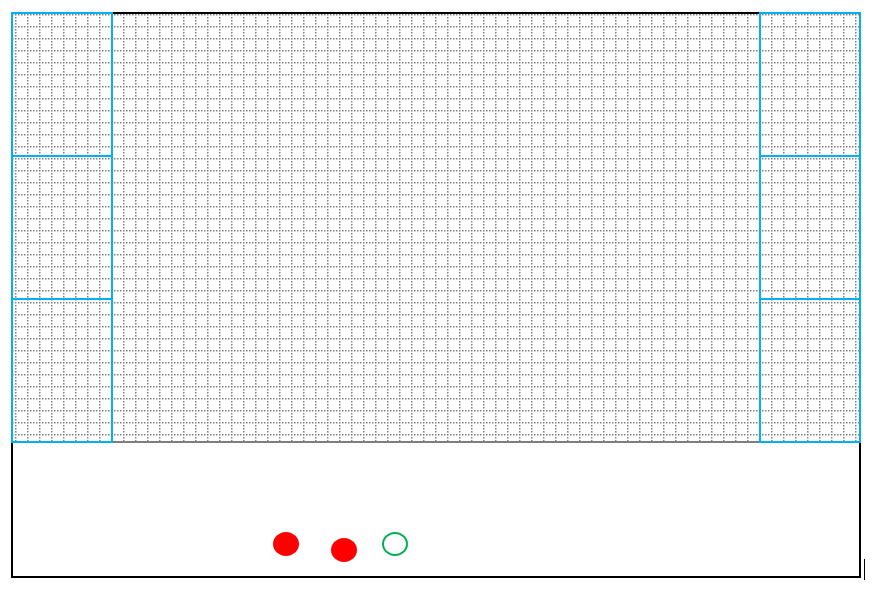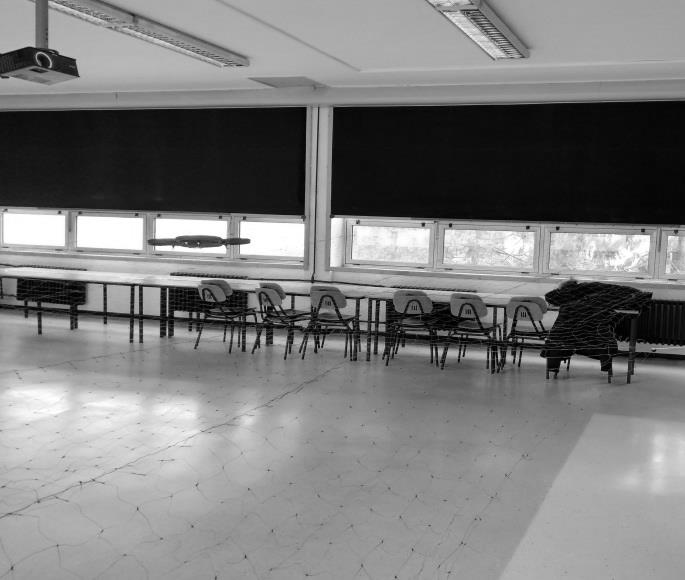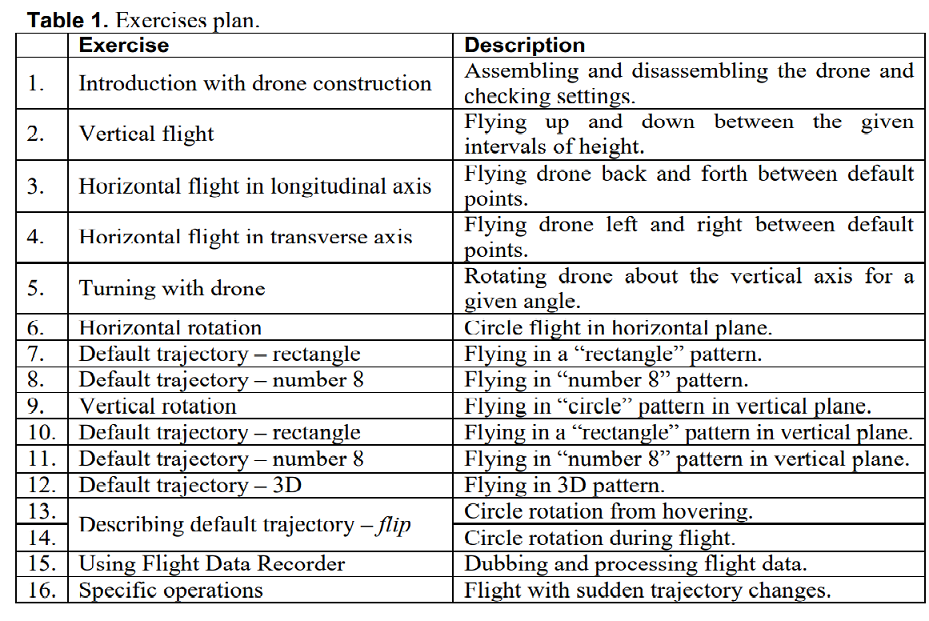INTRODUCTION
The practice has shown that the use of Unmanned Aerial Vehicles (UAVs) is broad. UAVs are used to collect meteorological data, transfer medical equipment, prevent natural disasters from leaking harmful substances into the environment, deliver commercial packages, perform agricultural work, survey in geodesy, search for casualties in accidents and elsewhere. Given the projected increase in the number of jobs that can be performed using UAVs, it is clear that the introduction of UAVs in education ensures the acquisition of competencies that increase competitiveness in the labour market. According to Future of Jobs Report[1] skills that involving UAVs are among the most wanted. In the list of categories of work skills and technologies likely to be adopted by 2025, by share of companies surveyed, rated the category of robots, non-humanoid (e.g. industrial automation, UAVs) with an average percentage of 10 %. This percentage indicates that drones are slowly becoming the mainstay of work across industries. Increasing the scope of use indicates the need for a systematic effect on the development of quality education in the areas covered by the use of drones. This can be achieved by using drones at all levels of education, from primary school to the college.
Use of drones in education provides new learning experiences to students by increasing their engagement and motivation in the learning process, particularly for student’s centric learning. Drones enable students to visualize a problem from different perspectives and become a better problem analyser which helps them to think critically and encourages them to be creative and provide innovative solutions[2]. Research shows that the use of drones has significantly improved students’ learning of spatial visualization and sequencing skills[3]. In this article is presented an insight into the current use of drones as part of education in Croatia.
DRONES IN EDUCATION
Drones in education make possible the acquisition of new knowledge using advanced technology, opening new trends and adding new dimensions to teaching and learning practices. Applying the acquired knowledge, students can assemble and make drones and write programs for flight control in various programming languages. On this way they develop skills and interest in robotics and informatics. Even with simple flight planning, the weight of the drone, the altitude at which drone flies, the speed, the length of the flight and the range of the drone must be considering. In such calculations, knowledge of mathematics and physics is applied. Likewise, drones can be used in the practical teaching of geography, in biology in the study of the environment, plant and animal species, in geodesy in mapping terrain, in medicine in the delivery of medical material. From this follows the conclusion that the use of drones in education can be divided into two concepts, the concept A – education about drones and the concept B – education by drones.
Concept A encompasses the use of drones in education where students use drones regardless of whether they construct or operate them. Concept B includes the application of drones in education where professors use drones to facilitate students’ acquisition of knowledge in field of physics, meteorology, geography, geodesy, photography, etc. The role of students in concept B is the processing and analysis of collected data. Concept B is more applicable at lower levels of education. At higher levels of education, both concepts are applicable because students have enough knowledge to be able to actively participate in class.
The European legislative framework prohibits that persons under 16 years, operate with more than 5 kg weighing drones[4]. Drones are most often used in the education of secondary vocational schools, in training for specific occupations, and in higher educational institutions as a special study subject, related to the construction and flight dynamics.
EDUCATIONAL APPLICATION OF DRONES IN CROATIA
In Croatia, the benefits of the use of drones in education are recognized and aligned with the National Curriculum of the Republic of Croatia for preschool, primary and secondary education[5]. Accordingly all legal frameworks that ensure the implementation of advanced technologies in curricular and extra-curricular activities are met. According to the applicable regulations on the rules and procedures for the operation of drones in European Union[4], obligatory in Croatia from 1 January 2021[6], teacher must know the legal acts and acquaint the students with the laws related to the management of unmanned aerial vehicles, taking into account the age of the person to whom they teach. The classes can be held indoors and outdoors. In the case of indoor classes, the pilot of the drone does not have to report the flight because it does not enter the airspace and in that case only regulations related to education are applied. In the case of outdoor operations all legal acts are applicable. In primary schools, students’ level of psycho-physical and cognitive development brings about additional aspects to be taken into account and all that points to the fact that toy-drones can be used[7].
According to user reports[8] and internet sources, the use of droned in education has been conducted for a definite period of time. That points to the fact that it is necessary to implement the systematic introduction of drones in the implementation and planning of classes. This article will present some of examples from practice:
the Geodetic Technical School in Zagreb[9] use drones to map terrain photogrammetric procedures for digital terrain model, without direct contact with the subject, provide reliable data that could be later analysed. In the teaching of geodesy, drones are also used as a teaching tool at the Technical School in Pula[10],
the first technical school Tesla[11] for the needs of teaching the subjects Robotics, Information and Communication and has acquired sets for students and teachers that contain modularly controlled robotic arms, drones, vehicles, sensors and other equipment,
students from School of Electrical Engineering in Varaždin used drone to film the attractions of Trakošćan castle[12]. Even if they cannot provide funds for the purchase of drones, schools often, in collaboration with the wider community and science popularisers, seek to provide presentations of working with drones and introduce students to modern technologies[13],
in project “Technologies, Innovation and Modernization for Education” (TIME), Agricultural and Forestry School in Vinkovci, includes teachers and students of 2nd, 3rd and 4th grade of educational programs agricultural phytopharmaceutical technician, agrotechnician, forestry technician and agricultural entrepreneur in three different professional practice programs - training for application of drones in agriculture, forestry and horticulture. Goal of the project is to introduce innovative teaching methods and modern techniques and technologies into the daily work of the institution and modernize the curriculum and harmonize content with the labor market. Students will acquire skills that they will desperately need in order to be as competent as possible in the labor market, but also in working on their family farms[14],
the Technical School Sisak is participating in the Drone Team project. They are collaborating on the project with schools from Spain, Poland and Slovenia and the AIJU, Institute of Technology in Spain. The aim of the project is to construct a manoeuvrable unmanned aerial vehicle and program its flight through given waypoints. The project envisages the construction of a drone and writing a dictionary with terms from this specific field. Constructed drone will use additional equipment such as GPS, cameras and First Person View (FPV). All materials will be published under an open license as Open Educational Resources (OER)[15],Current status of the use of drones in education in Croatia
Vladimir Prelog School of Science in Zagreb, in cooperation with the Andrija Mohorovičić gymnasium in Rijeka, the Faculty of Science in Zagreb and the pharmaceutical company Pliva, implemented the Science Plus project. As a result of this project is curricula created for 15 new optional subjects that have already been introduced in teaching[16]. One of the modern, innovative subjects is Bionics. The course connects biology and technical sciences. Biological forms and abilities of living organisms are a model for making and assembling a bionic spacecraft,
aeronautical technical school Rudolf Perešin, Croatian Post Inc., Greek and Cyprus Post and partner companies Dronint, AKME and BK Consult, signed a grant agreement with the Agency for Mobility and EU Programmes for the implementation of the project entitled "Fly VET Up!”[17]. Through this project, it is planned to develop a Curriculum for drone pilot.,
“LOKO LAG – Sustainable Rural Development” project includes 14 primary schools and during the project each involved school will receive one drone[18]. It is planned that 140 students will be educated and trained to work with drones. In addition to students, their teachers would also underwent this training so that they could later pass on knowledge to the next generations, because upon completion of the project, all equipment remains with the school for further use, all for the purpose of educating future generations.
In these examples of the use of drones in secondary schools, the concept B s prevalent. Further in this text, a detailed description of a well-structured example of concept A follows.
CASE STUDY OF EDUCATIONAL DRONE USE IN FACULTY OF MECHANICAL ENGINEERING AND NAVAL ARCHITECTURE, UNIVERSITY OF ZAGREB
In Faculty of mechanical engineering and naval architecture, University of Zagreb, drones were used in higher education. Classes included several elective courses – Unmanned Aerial Vehicles Equipment, Navigation Systems and Unmanned Aerial Vehicles Systems, in which students acquire basic understanding and develop competencies of drone usage. About 50 students underwent training through these courses.
The classes consisted of students being introduced to the regulations on the rules and procedures for the operation of drones[4], construction of drones, their technical characteristics, associated equipment and flying. Accordingly, the lessons were divided into the following sections:
theory – regulations, meteorology, etc.,
simulation training,
written instructions,
demonstration of work with drones (preflight and post-flight inspection),
practical work with drones (preflight and post-flight inspection) and
post-flight reports.
The structure of one hour of practical classes is elaborated further in the text.
The training of students was conducted indoors, in the classroom, where the training ground was set up. Figure 1 shows a schematic representation of the training ground where the blue rectangles mark the edges of the tables, the gray grid represents the safety net, the red circles the students and the green circle the flight supervisor. It is to be emphasized that the training area was set in the regular classroom.

Figure 1. Schematic representation of the training ground. Rectangles on the left and right sides are tables used during other classes, smaller-scale net is safety net, filled circles are positions for students while empty circle is position where flight supervisor stood.
The training ground was secured by a safety net that restricted the movement of students, and at the same time protected the drone from damage. Figure 2 shows real situation during practical class where drone is marked by larger ellipse. A series of circles mark some of the nodes of the net spanned through most of the classroom.
To access practical class, students had to adhere to the following guidelines:
• it is required to participate in the classes only during the pre-registered time interval,
• it is required to come to the class with printed, red and understood procedures planned for the particular training,
• it is required to strictly and immediately follow the flight supervisor instructions during the class.
Access to the training ground in a practical class’s period was allowed to the following persons:
• flight supervisor,
• two students who were scheduled for class,
• other persons only after permission of flight supervisor.
On the outside of the door was a clear sign that in the classroom is a practical class with drones.
Upon arrival at training ground and before each class, students had to check the safety net for damage and inform everyone present at the training ground about its condition. After checking the safety net, the students performed a pre-flight inspection of the drone. The preflight inspection includes checking the drone and remote control for damaged, battery status, are propellers attached to the engines and can they rotate freely. Each battery, which was used,Current status of the use of drones in education in Croatia
is given an enumeration that enables the flight supervisor to fill-in the table of charging and discharging for each battery.
After determined pre-flight inspection students performed assigned exercises prescribed by training plan. In case that flight supervisor issues an additional instruction, the student (drone pilot) immediately conducts necessary corresponding actions. In case of a need, the flight supervisor takes over the drone control.
Through classes, the students successfully conducted 16 exercises related to the use of drones in a wide range of situations, Table 1. As shown in Table 1, the exercises covered various segments of drone flight such as vertical flight to restricted high, different types of horizontal flights, flights in tri-dimensional trajectories, flight with sudden trajectory changes and flight data processing.
After the completion of the flight, drone pilot conducts post-flight check of the drone. Drone pilot reports any observations to the flight supervisor along with handing in the drone. After each training flight supervisor filled Flight report, Table 2.
CONCLUSION
The application of drones is broad and includes various professions. This number of professions is expanding every day and there is a need for people who are properly and professionally educated to be able to use all the potentials that drones provide. Education for their use should be started at the lowest possible level of education.
The data collected about the drone use in education in Croatia point to the current spread of the use of drones in diverse aspects of education. Owing to the relative modernity of these uses, drones can currently be considered as a novel technology, thus the statistical analysis of their use cannot be conducted in details. However, qualitatively, pattern of drone introduction into education follows the average introduction of advanced technologies into education.



